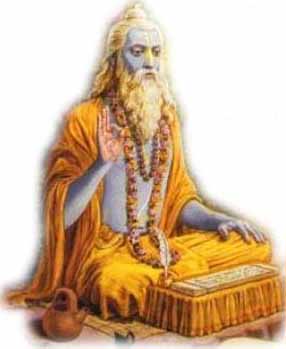Sports and Games in Ancient India
Games such as Chess, Snakes and Ladders, Playing Cards, Polo, the martial arts of Judo and Karate had originated in India and it was from here that these games were transmitted to foreign countries, where they were further developed.
Several games now familiar across the world owe their origins in India, particularly, the games of chess, ludo (including ladders and snake), and playing cards. The famous epic Mahabharata narrates an incidence where a game called Chaturang was played between two groups of warring cousins.
The age when epic Mahabharata was written is variously dated around 800 BC to 1000 BC. In some form or the other, the game continued till it evolved into chess. H. J. R. Murry, in his work titled
A History of Chess,has concluded that chess is a descendant of an Indian game played in the 7th century AD.
The game of cards also developed in ancient India. Abul Fazal was a scholar in the court of Mughal emperor Akbar. In his book,
Ain-e-Akbari, which is a mirror of life of that time, records game of cards is of Indian origins.Martial arts by the name of Kalaripayattu were a native of Kerala, a state of India. Kalaripayattu consists of a series of intricate movements that train the body and mind.
Chess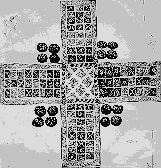
Chess originated in ancient India and was known as
Chatur-Anga - Meaning 4 bodied, as it was played by 4 players. From this name we have its current name
Shatranj. One such instance is in the Mahabharata when Pandavas and Kauravas play this game. Yudhistira the eldest of the Pandavas places his bets on his kingdom, his wife Draupadi and all other material possessions. And by a malevolent trick he loses to the Kauravas everything that he had placed his bets on. Consequently to humiliate the Pandavas, Dushasana one of the evil Kaurava brothers takes hold of Draupadi whom Yudhisthira has lost to the Kauravas, and tries to disrobe her in front of the assembled court. The Pandavas though powerful are helpless as they have lost Draupadi and according to the rules of the game they have no claim on her anymore.
In distress, Draupadi invokes Lord Srikrishna to come to her rescue. And in answer to her prayers the lord appears and in a miracle sends a continuous stream of apparel to clothe Draupadi's body. The evil Dushasana tires himself out trying to tear away Draupadi's clothes but he is powerless against the divine strength of Lord Srikrishna. After hours of struggling to achieve his evil intention he falls unconscious to the floor. Draupadi's honor is saved. In deference to Lord Srikrishna's wishes, the Kauravas relinquish their claim to Draupadi. But in return the Pandavas are obliged to relinquish their kingdom for fourteen years and go into exile in forests, after which they return and regain their from the Kauravas, but not before a devastating war is fought between the two clans on the battlefield of Kurutshetra.
The Mahabharata story throws light on the fact that a game similar to Chess was played in ancient India. The Mahabharata is variously dated around 800 and 1100 B.C. Thus this game was known in India nearly 3000 years ago. It is the view of some historians that this game was also used in the allocation of land among different members of a clan when a new settlement was being established.
The Indian origin of the game of chess is supported even by the Encyclopedia Britannica according to which, "About 1783-89 Sir. William Jones, in an essay published in the 2nd Vol. of Asiatic Researches, argued that Hindustan was the cradle of chess, the game having been known there from time immemorial by the name Chaturanga, that is, the four angas, or members of an army, which are said in the Amarakosha (an ancient Indian Dictionary - S.B.) to be elephants, horses, chariots and foot soldiers.
As applicable to real armies, the term Chaturanga is frequently used by the epic poets of India. Sir William Jones' essay is substantially a translation of the Bhawishya Purana, in which is given a description of a four-handed game of chess played with dice.
Sir William, however, grounds his opinions as to the Hindu origin of chess upon the testimony of the Persians and not upon the above manuscript. He lays it down that chess, under the Sanskrit name Chaturanga was exported from India into Persia in the 6th century of our era; that by a natural corruption, the old Persians changed the name into chatrang; but when their country was soon afterwards taken possession of by the Arabs, who had neither the initial nor the final letter of the word in their alphabet, they altered it further into Shatranj, which name found its way presently into modern Persian and ultimately into the dialects of India.
The further says that Wander Linde, in his exhaustive work,
Geschichte and Litteraturdes Schachspiels (1874), has much to say of the origin-theories, nearly all of which he treats as so many myths. He agrees with those who consider that the Persians received the game from the Hindus.
The outcome of his studies appears to be that chess certainly existed in Hindustan in the 8th century, and that probably that country is the land of its birth. He inclines to the idea that the game originated among the Buddhists, whose religion was prevalent in India from the 3rd to the 9th century.
According to their ideas, war and slaying of one's own fellow-men, for any purpose whatever, is criminal, and the punishment of the warrior in the next world will be much worse than that of the simple murderer, hence chess was invented as a substitute for war.
H.J.R. Murry in his monumental work
A History of Chess, concludes that chess is a descendant of an Indian game played in the 7th century.
According to the Encylopedia - altogether, therefore, we find the best authorities agreeing that chess existed in India before it is known to have been played anywhere else. In this supposition they are strengthened by the names of the game and some of its pieces. Shatranj as Forbes has pointed out, is a foreign word among the Persians and the Arabians, whereas its natural derivation from the term Chaturanga is obvious. Again affix the Arabic name for the bishop, means the elephant, derived from alephhind, the Indian elephant.
Even the word checkmate is derived from the Persian term Shah Mat which means 'the king is dead!'. The Sanskrit translation of this term would be Kshatra Mruta. Another term viz. 'the rooks' which is the name for one set of the counters used in chess, originated from the Persian term Roth which means a soldier. The Persian term according to the Encyclopedia is derived from the Indian term Rukh, which obviously seems to have originated in the Sanskrit word Rakshak which means a soldier from Raksha which means 'to protect'.
About the introduction of this game into Persia, the Encylopedia says that the Persian poet Firdousi, in his historical poem, the Shahnama, gives an account of the introduction of Shatranj into Persia in the reign of Chosroes I Anushirwan, to whom came ambassadors from the sovereign of Hind (India), with a chess-board and men asking him to solve the secrets of the game, if he could or pay tribute. The king asked for seven days grace, during which time the wise men vainly tried to discover the secret. Finally, the king's minister took the pieces home and discovered the secret in a day and a night.
The concludes that "Other Persian and Arabian writers state that Shatranj came into Persia from India and there appears to be a consensus of opinion that may be considered to settle the question. Thus we have the game passing from the Hindus to the Persians and then to the Arabians, after the capture V of Persia by the Caliphs in the 7th century, and from them, directly or indirectly, to various parts of Europe, at a time which cannot be definitely fixed, but either in or before the 10th century. That the source of the European game is Arabic is clear enough, nor merely from the words "check" and "mate", which are evidently from Shah mat ("the king is dead"), but also from the names of some of the pieces.
Thus it was from India that the ancient Persians are said to have learnt this game, and from them it was transmitted to the Greco Roman world. The evidence of the Persians having borrowed this game from India is seen in the name the Persians gave to it. The Persian word for chess is Chatrang, which was later changed by the Arabs to Shatranj. As said in , this word is obviously a corruption of the Sanskrit original Chaturanga.
The other term
Astapada meaning eight steps, which was also used to describe this game in ancient India, perhaps was a description for the eight steps (Squares) which the modern Chessboard, has. The modern Chessboard is checkered with 64 (8 x 8) squares in all, with eight squares on each side. The old English word for chess which is Esches, possibly stems from this eight squared aspect of the game as did the Sanskrit word
Astapada.
Cards
Ancient India was the birthplace of the game of playing cards and has since spawned a plethora of card based games which are played the world over. Some of the most popular games such as blackjack, baccarat and poker. For reference
Casino.org has a list of strategies for these card games.
The game of playing cards was also one of the favorite pastimes of Indians in ancient times. This game was patronized especially by the royalty and nobility. This game was known in ancient times as Kridapatram, in the middle ages, it was known as Ganjifa.
In medieval India Ganjifa cards were played in practically all royal courts. This game is recorded to have been played in Rajputana, Kashyapa Meru (Kashmir), Utkala (Orissa) the Deccan and even in Nepal. The Mughals also patronized this game, but the Mughal card-sets differ from those of the ancient Indian royal courts.
Some scholars are of the opinion that this game was in fact introduced into India by the Mughals. But according to Abul Fazal author of the Ain-e-Akbari, the game of cards was of Indian origin and that it was a very popular pastime in the Indian (Hindu) courts when the Muslims came into India.
According to Abul Fazal's description of the game, the following cards were used. The first was Ashvapati which means 'lord of horses'. The Ashvapati which was the highest card in, the pack represented the picture of the king on horseback. The second highest card represented a General (Senapati) on horseback. After this card come ten other with pictures of horses from one to ten.
Another set of cards had the Gajapati (lord of elephants) which represented the king whose power lay in the number of elephants. The other eleven cards in this pack represented the Senapati and ten others with a soldier astride an elephant. Another pack has the Narpati, a king whose power lies in his infantry. We also had other cards known as the Dhanpati, the lord of treasures, Dalpati the lord of the squadron, Navapati, the lord of the navy, Surapati, the lord of divinities, Asrapati, lord of genii, Vanapati, the king of the forest and Ahipati, lord of snakes, etc.
On the authority of Abul Fazal we can say that the game of playing cards had been invented by sages in ancient times who took the number 12 as the basis and made a set of 12 cards. Every king had 11 followers, thus a pack had 144 cards. The Mughals retained 12 sets having 96 cards. These Mughal Ganjifa sets have representations of diverse trades like Nakkash painter, Mujallid book binder, Rangrez, dyer, etc., In addition there were also the Padishah-i-Qimash, king of the manufacturers and Padishah-izar-i-Safid, king of silver, etc.
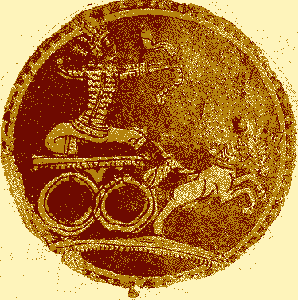
Cards were known as
Krida-patram in ancient India. These cards were made of cloth and depicted motifs from the Ramayana, Mahabharata, etc. A tradition carried on today with floral motifs and natural scenery.
The pre-Mughal origin of the game of cards is evident if we examine the pattern of painting the cards. We also find that despite the observation of Abul Fazal that Akbar introduced the pack with 8 sets, we find that even earlier, in Indian (Hindu) courts we have packs with 8, 9 and 10 sets apart from the usual 12. The numbers were derived from the eight cardinal directions Ashtadikpala, for the pack with 8 set, from the nine planets Navagraha for the one with 9 sets and from ten incarnations Dashavatara of Vishnu for the pack with 10 sets.
Themes from the Ramayana and Mahabharata are painted on these cards. The largest number of such cards are to be found in Orrisa. The largest number of such cards are to be found in Orissa. The painters from Orissa have represented various illustrations like the Navagunjara, a mythical birdhuman animal which was the form assumed by Sri Krishna to test Arjuna's fidelity, il lustrations from the Dashavatata of Vishnu are also portrayed.
All these cards were hand-made and were painted in the traditional style. This required considerable patience and hard meticulous work. The kings usually commissioned painters to make cards as per their preference. The commoners got their cards made by local artists who were to be ; found in urban and rural areas. In order to -obtain the required thickness a number of sheets of pieces of cloth were glued together. The outlines of the rim were painted in black and then the figures were filled with colors.
As cards were played by members all strata of society we find different types of cards. Some cards were also made of ivory, tortoise shell, mother of pearl, inlaid or enameled with precious metals. The cards were of different shapes; they were circular, oval rectangular, but the circular cards were more common. The cards were usually kept in a wooden box with a lid painted with mythological figures. This art of handmade, hand painted cards which had survived for hundreds of years. gradually feel into decay and became extinct with the introduction of printed paper cards by the Europeans in the 17-18th centuries. With the extinction of the art of making and painting cards also was erased the memory that Indians ever had played the game of cards with their own specific representations of the Narapati, Gajapati and Ashvapati.
Martial Arts
Ancient India claims to have been the origin of Judo and Karate. Something similar to karate, it was called
Kalaripayate.
This art from seems to have traveled from India to the countries of the far-east along with the Buddhist religion. Buddhists monks who traveled barefoot and unarmed to spread the gospel of Buddha seem to have accepted this art with alterations suitable to the philosophy of nonviolence. Such a technique of defense would have been necessary for them as they traveled individually or in small groups in foreign lands during which they were exposed to dangers from bandits and fanatics from other religions. Buddhist monks seem to have tempered the originally violent character of this art. The violent and exterminative nature of Kalaripayate is evident from the daggers and knives that are used. Unlike Kalaripayate, Judo and Karate do not allow the use of lethal weapons.
The aim of a Karate practitioner is mainly to disarm and disable his opponent without mortally wounding him. This can be looked upon as a reflection of the Buddhist attitude towards life. Further both Judo and Karate are deeply interwoven with meditation unlike other martial arts like boxing, wrestling, fencing, etc. The concentration aspect in Judo and Karate perhaps stems from this. Both Judo and Karate are sought to be kept as arts to be used for just purposes for protection of the weak, etc.,
The oath that every student of these disciplines has to take is evidence of this. A teacher of Judo or Karate traditionally commands deep respect of students and a lesson always starts with a bow of the students to the teacher. The teacher here is not looked upon only as a coach as in western martial arts like boxing and fencing. This relationship between a teacher and student in Judo and Karate could have its roots in the Guru-Shishya tradition of India. Thus it is quite possible that these martial art forms originated in southern India and were transmitted to China, Korea and Japan by Buddhist monks. But it has to be conceded that they were neglected in India where like Buddhism they atrophied and today the world considers them to be a legacy bequeathed by the countries of the far-east.
Physical perfection has been an integral part of Hinduism. One of the means to fully realize one's Self is defined as the body - way or
dehvada.
Salvation was to be gained through physical perfection or kaya sadhana, possible only through perfect understanding of the body and its functions. The capstone of Hatha Yoga is strength, stamina and supreme control of the body functions. The zenith of the whole experience is the fusion of meditation and physical movement.
The ' eight - fold method ' encompasses techniques associated with breathing control or pranayama, body posture or asanas, and withdrawal of the senses or pratyahara.
Religious rites provided the needed impetus to physical culture in ancient India. Many of the present day Olympic disciplines are sophisticated versions of the games involving strength and speed that were common in ancient India and Greece.
During the era of the Rigveda, Ramayana and Mahabharata, men of a certain stature were expected to be well - versed in chariot - racing, archery, military stratagems, swimming, wrestling and hunting. Excavations at Harappa and Mohenjodaro confirm that during the Indus valley civilization ( 2500 - 1550 B.C ) the weapons involved in war and hunting exercises included the bow and arrow, the dagger, the axe and the mace.
These weapons of war, for instance, the javelin (
toran) and the discus (
chakra), were also, frequently used in the sports arena. Lord Krishna wielded an impressive discus or Sudarshan chakra. Arjuna and Bhima, two of the mighty Pandavas, excelled in archery and weightlifting respectively. Bhimsen, Hanuman, Jamvant, Jarasandha were some of the great champion wrestlers of yore.
Women also excelled in sport and the art of self - defence, and were active participants in games like cock fighting, quail fighting, and ram fighting.
With the flowering of Buddhism in the country, Indian sport reached the very peak of excellence. Gautam Buddha himself, is said to have been an ace at archery, chariot - racing, equitation and hammer - throwing.
In
Villas Mani Manjri, Tiruvedacharya describes many of these games in detail.
In
Manas Olhas - 1135 AD. - Someshwar writes at length about bharashram (weight lifting), bharamanshram (walking), both of which are established Olympic disciplines at present, and
Mall - Stambha, a peculiar form of wrestling, wherein both contestants sit on the shoulders of their 'seconds', who stand in waist - deep water throughout the game.
The renowned Chinese travelers Hieun Tsang and Fa Hien wrote of a plethora of sporting activities. Swimming, sword - fighting ( fencing, as we know it today ), running, wrestling and ball games were immensely popular among the students of Nalanda and Taxila.
In the 16th century, a Portuguese ambassador who visited Krishnanagar was impressed by the range of sports activity, and the many sports venues, in the city. The king, Raja Krishnadev was an ace wrestler and horseman, himself.
The Mughal emperors were keen hunters of wild game, and avid patrons of sports, especially wrestling.
The Agra fort and the Red Fort were the popular venues of many a wrestling bout, in the times of Emperor Shahjahan.
Chattrapati Shivaji's guru, Ramdas, built several Hanuman temples all over Maharashtra, for the promotion of physical culture among the youth.
Kerala's martial art form, Kalari Payattu, is very similar to Karate. Those who practice it have to develop acrobatic capabilities, when using swords or knives to attack their adversaries, and even an unarmed exponent can be a force to reckon with. With the advent of Buddhism, this art form spread to the Far East countries.
Buddhist monks who travelled far and wide, mostly unarmed, to spread the teachings of the Buddha, accepted this form of self-defense, against religious fanatics, with alternatives that were suitable to their philosophy of non - violence.
The relationship between a student and teacher in the disciplines of Judo and Karate could trace its roots to the guru - shishya tradition, India was, and continues to be famous for. It is quite possible that some of our martial art forms travelled to China, Korea and Japan, but as in the case of Buddhism, atrophied in India.
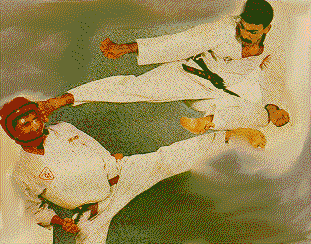
The technique of Pranayama or breathing control, which is a prominent feature of Tae - kwan - do, Karate, Judo and Sumo wrestling was one of the many techniques spread in the Far East by Buddhist pilgrims from India. The idea that man enters into harmony with the five elements, through the science of breathing, is to be found in the most ancient records of Indian history.
If mind and body are one, the possibilities of development of one's physical and mental capabilities are limitless, provided they are united and controlled. Using this as the foundation, Bodhidharma, a Buddhist monk started a new trend in the Shaolin temple in China, from which probably stemmed most of the rules and precepts which govern all martial art forms.
Festivals and local fairs are the natural venues of indigenous games and martial arts. Post - Independence the government made special efforts to preserve and nurture the awesome cultural heritage, by setting up a number of new incentives, and by heightening media exposure at the national level, to propagate and popularize indigenous games.
Now you can purchase Board games, Card games, Wooden toys, Special toys, Puzzle games and much more



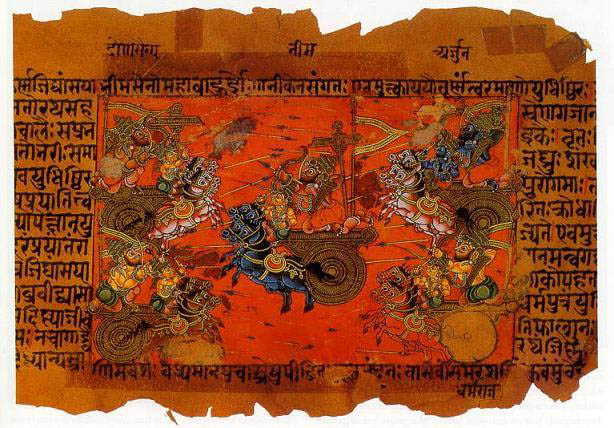
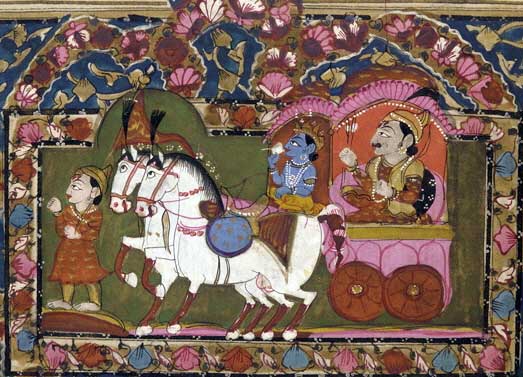 Krishna in blue riding in a chariot
Krishna in blue riding in a chariot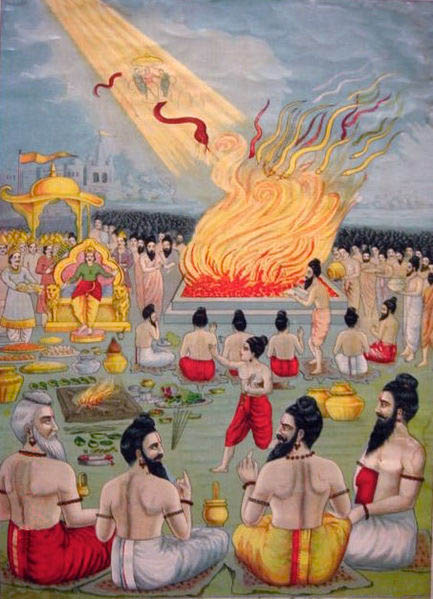 The snake sacrifice of Janamejaya
The snake sacrifice of Janamejaya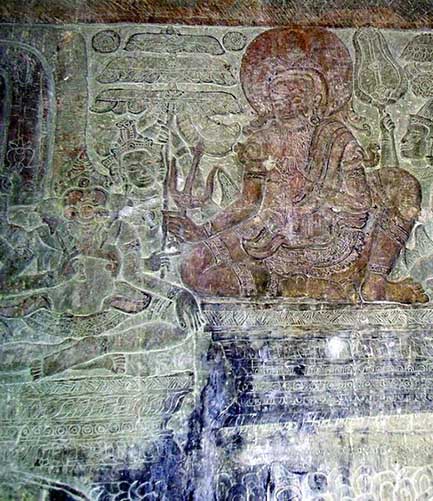 Depiction at Angkor Wat of Vyasa narrating
Depiction at Angkor Wat of Vyasa narrating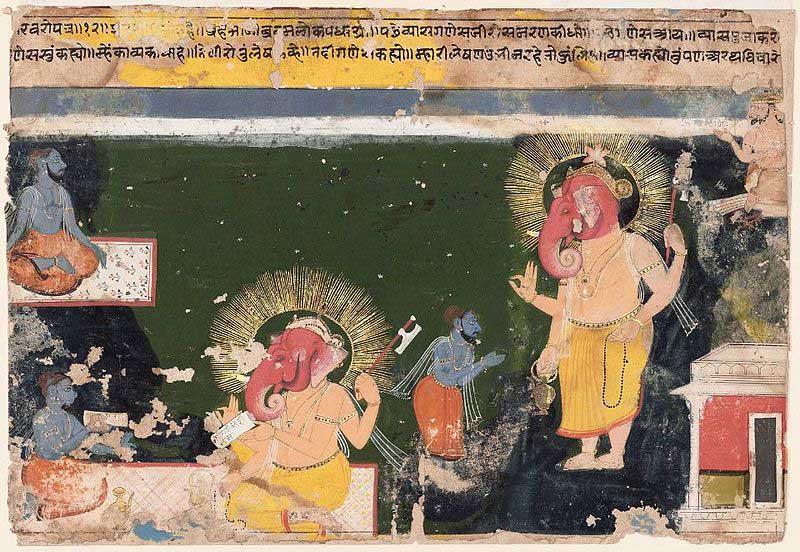 Ganesha writing the Mahabharata
Ganesha writing the Mahabharata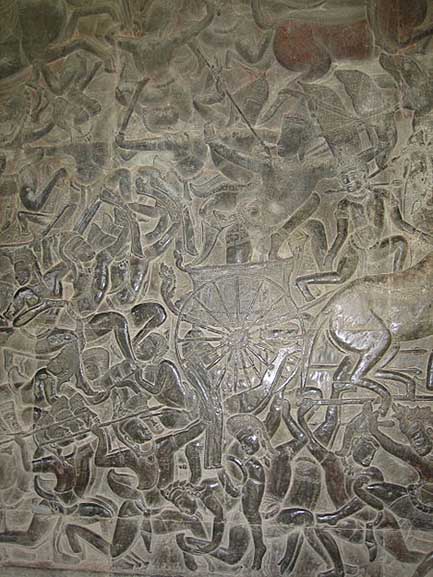
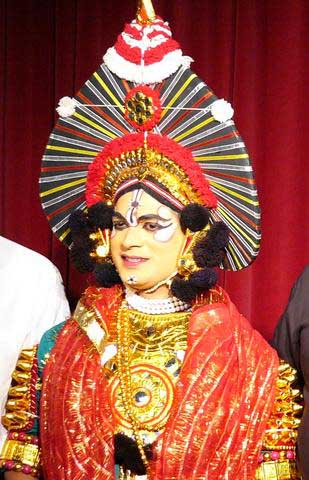 Krishna as portrayed in Yakshagana from Karnataka
Krishna as portrayed in Yakshagana from Karnataka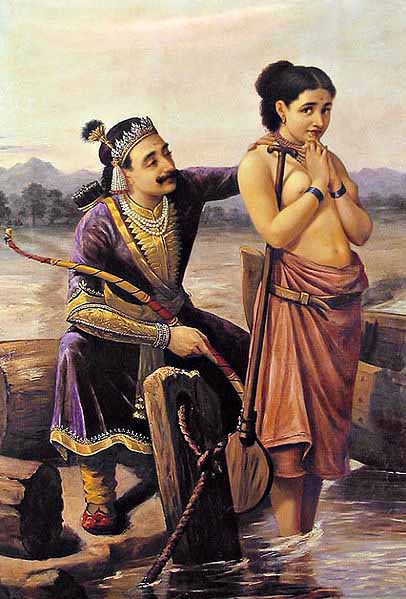 Shantanu woos Satyavati, the fisherwoman
Shantanu woos Satyavati, the fisherwoman


